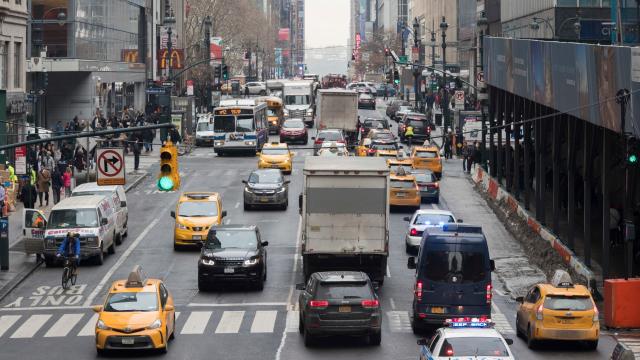The challenges facing autonomous car companies are generally separated into two categories: getting the technology to work and getting society to accept the technology. And a recent New York Times article makes the case that the rest of society should make an awful lot of concessions to get out of the self-driving cars’ damn way, both figuratively and extremely literally.
It is a scary entrant into a growing genre of sacrifices the rest of society should make to fuel techno-utopian fever dreams and another piece of evidence that business and tech experts refuse to accept that just because something can be built that doesn’t mean it should be built.
The story, with the headline precisely engineered to piss off city-dwellers “How Jaywalking Could Jam Up the Era of Self-Driving Cars,” was written by Eric A. Taub, who according to his Twitter bio is a “Corporate consultant in healthcare and CE.”
The article’s thesis is that the general way our societies work pose an existential threat to AV deployment:
In New York, the unwritten rule is plain: Cross the street whenever and wherever — just don’t get hit. It’s a practice that separates New Yorkers from tourists, who innocently wait at the corner for the walk symbol. But if pedestrians know they’ll never be run over, jaywalking could explode, grinding traffic to a halt.
I have bad news for Mr. Taub about traffic in New York: it has always, always been at a halt, even prior to cars. In fact, it is perhaps the singular constant for the entire history of New Amsterdam/New York that the streets have been a chaotic mess.
But the truly insane part is what came after that paragraph:
One solution, suggested by an automotive industry official, is gates at each corner, which would periodically open to allow pedestrians to cross.
That prospect seems as likely as never-late subways. But it’s an example of the thinking by those who worry about planning for the future.
If this truly is “an example of the thinking” by automotive officials about how to make our cities usable for self-driving cars, we are profoundly screwed.
The article goes on to name-check a couple of the most oft-repeated tropes about the “benefits” of AVs, such as the reduction in parking needs since “autonomous cars can simply park themselves anywhere, or circle around until they’re needed,” with no examination of whether these are even desirable goals.
Why should we want a constantly-circling army of cars? Why is that good? When I hear someone propose an idea of cars circling until they’re needed, that’s just traffic. If you think traffic is bad now, just wait until cars literally never park. And traffic, as Taub mentioned earlier, is bad.
On top of that, such a vision entails an awful lot of wasted energy, something I humbly posit we should not be advocating for while our planet is burning, even if it comes via the electrical grid which is still getting the majority of its energy from fossil fuels.
Indeed, the entire article, from its proposal that cars be programmed differently depending on the city to abide by local customs even if it means breaking laws — does that mean New York AVs will, for example, drive in bike lanes? — to the idea that owners can choose whether their cars drive aggressively or conservatively, seems to undermine the entire premise of AVs as an improvement.
This is the fundamental — and, to my mind, existential — question facing the AV industry: how do you program robot cars to behave like humans while still being an improvement over humans? And if a robot car programmed to provide all the safety benefits that the AV industry promises gets immobilised by something as simple and as commonplace as jaywalkers, what’s the point of the robot car?
At what point do these business-focused individuals stop and wonder if maybe AVs have a far more limited use case than they have so far assumed?
Perhaps there is no real difference between so-called “technological” or “societal” problems with AVs. Maybe, just maybe, if your technology does not fit within the basic norms under which our species operates, then your technology is simply bad. Maybe the problem isn’t us, but you.
This would all be a fun thought experiment if we didn’t have ample evidence the auto industry can and will remake society to fit its profit motive. And yes, cars have enabled humans to move around in ways never imagined before and provided many societal benefits by doing so, but they have also caused tremendous harm.
After all, the fundamental problem AVs are supposed to solve, the tens of thousands of people killed on roads each and every year, is the end result of the auto industry’s ability to reshape every aspect of our society to fit its goals.
Yes, they have done it before, both by getting the U.S. government to pay for the very roads they depend on — while disinvesting in nearly all forms of public transportation until about 30 years ago — and by changing the American legal code in profound ways. As detailed by law professor Gregory Shill:
To begin with, mundane road regulations embed automobile supremacy into federal, state, and local law. But inequities in traffic regulation are only the beginning. Land-use law, criminal law, torts, insurance, vehicle safety regulations, even the tax code — all these sources of law provide rewards to cooperate with what has become the dominant transport mode, and punishment for those who defy it.
When I read articles like that new one in the New York Times, it fills me with dread that we are not going to learn from any of our mistakes, but instead repeat them. Laugh now at the idea of caging pedestrians onto the footpaths, but once upon a time in New York, there was no such thing as a footpath.
